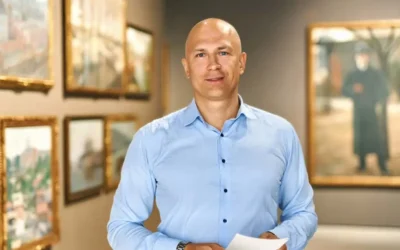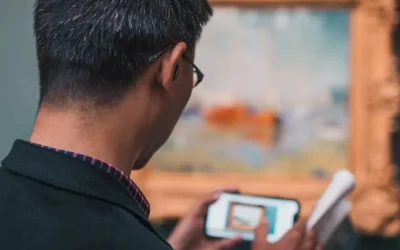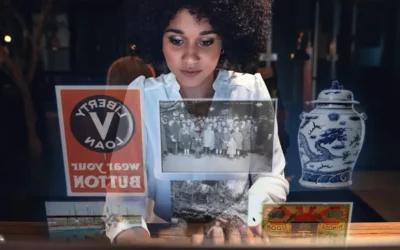Ray Harryhausen | Titan of Cinema Virtual Exhibition Experience

Rachael Cristine Woody
Over a year dealing with COVID-19 has proven to many museum professionals just how critical a robust online presence is for serving our collections to an audience.
I’ve written about this forced shift from physical to digital in a few previous posts (linked below). For this miniseries I want to focus on a specific example as provided by the National Galleries Scotland (NGS). In 2020 the Ray Harryhausen | Titan of Cinema exhibition was meant to open and celebrate what would have been Harryhausen’s centenary year. Due to COVID the exhibit was forced to close prematurely, but it inspired NGS to pivot to an online, virtual exhibition.
To read my previous posts analyzing our COVID-19-led shift to online and digital, please see Museum Forecast 2021, TrendsWatch 2021: Digital Awakening, and post LAMs are More Alike Than Different: Physical vs Digital Nature of the Work.
Tickets for the Ray Harryhausen | Titan of Cinema Virtual Exhibition Experience are £10 and are good for the duration of the exhibition—until February 20, 2022. These tickets are also promised to grant access to bonus live events provided via an online platform; for which there are no details at present.
Who is Ray Harryhausen?
In the introductory video to the exhibition, Simon Groom, Director of Modern and Contemporary Art at NGS describes Ray Harryhausen as a true artist of the 20th century. While Harryhausen’s work is contemporary in nature, its roots in historical art tradition and its influence on the filmmaking industry—and thus modern culture—cannot be overstated. Harryhausen was a man of many talents. His work with engineering, animating, and filming models began when he was an adolescent and encouraged by his parents. When listening to the interviews and seeing his work presented in its totality, viewers come to understand why Harryhausen was most famous for his ability to endow his creatures with a spirit of their own. In what many describe as his “empathetic vision”, Harryhausen was able to lend a magical, yet believable quality to his models.
The 5 Main Areas of the Virtual Exhibition Are:
- King Kong and the Early Years
- Bringing Imagination to Life
- Dynamation: Making Movie Miracles
- Creatures of Legend
- A Life in Objects
The Virtual Exhibition Includes:
- Five specially created films that explore different facets of Harryhausen’s career and feature interviews with Harryhausen’s daughter and Harryhausen Foundation Trustee Vanessa Harryhausen, and fellow filmmakers and artist: Martine Beswick, Mark Caballero, Randy Cook, Barry Purves, Vanessa Harryhausen, Marshall Julius, Mark Millar, Caroline Munro, John Walsh and Seamus Walsh;
- Images and texts from the exhibition;
- Archive films and objects from Harryhausen’s life and work;
- And 3D model videos created by Playdead of the Harpy, Hydra, and Skeletons. The scans that were used for the 3D rendering process were captured by students from the Glasgow School of Art.
A Vision for the Exhibition
Curator Groom explains that they wanted to imbue the physical exhibit with the interactive and immersive elements Harryhausen is known for. And while Groom doesn’t directly state this, it’s clear that this intent was also applied to the exhibit’s translation online.
Exhibition Trailer
The following video serves as a “movie trailer” to the exhibition:
A Few Viewpoints for Analysis
A virtual exhibition of this size and scope lends itself to a few forms of analysis. In this miniseries I’m going to explore:
- The translation of an exhibit from physical to virtual
- Use of archival materials add enrichment to the story
- The virtual user experience from someone who loves museums, but isn’t a museum professional
Stay tuned next week as we continue the miniseries by analyzing the translation of the Harryhausen exhibit from physical to virtual.

Rachael Cristine Woody
Expert, consultant and blogger Rachael Cristine Woody advises on museum strategies, collections management, digital museums, and grant writing for a wide variety of clients. She is a popular presenter and Lucidea Press author. For more on museum success, learn about Lucidea’s Argus Museum CMS for virtual, multimedia presentation of collections, visitor engagement, and museum staff productivity and impact.
Similar Posts
Storytelling to Inspire Reflection Using Museum Collections Online
Storytelling with online collections is impactful, whether we choose online-only or as part of a hybrid approach to museum exhibitions.
Museum Collections Online: Learning Through Storytelling
Digitizing museum collections introduces new and engaging opportunities for storytelling. By leveraging digital surrogates—essentially online representations of physical objects—museums can enhance how they present narratives and information to audiences.
The Role of Museum Collections Online in Storytelling & Audience Engagement
Storytelling with museum collections online allows for a great degree of flexibility, offers additional detail, and lends a dynamism that is difficult to produce within a physical exhibition.
Examples of How Archives Can Be Used to Elevate Museum Collections
Last week we reviewed how archives can enhance museum collections online. This week will continue our work with an examination of specific examples, including what items different types of archives may contain and where to capture this data.




Leave a Comment
Comments are reviewed and must adhere to our comments policy.
0 Comments